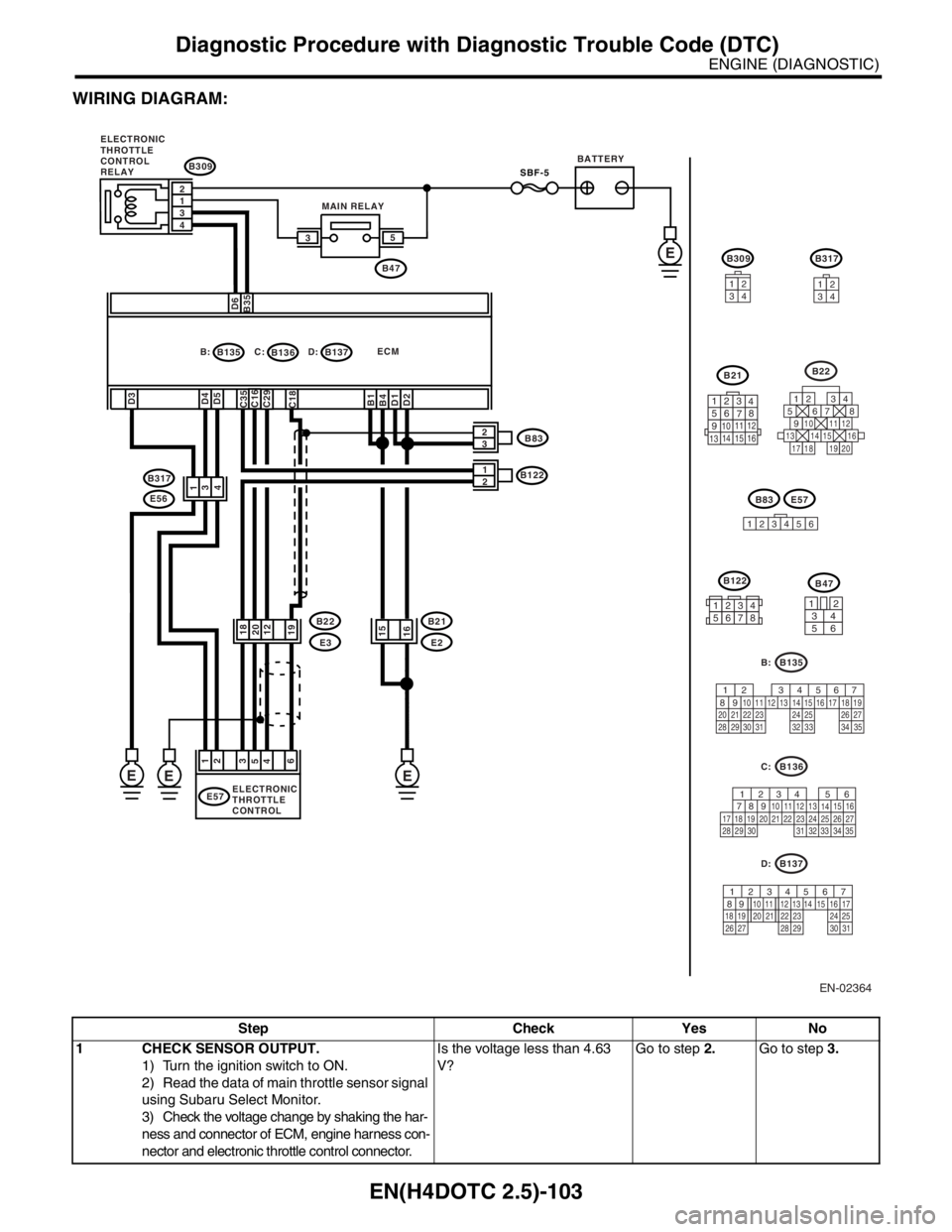2004 SUBARU FORESTER turn signal
[x] Cancel search: turn signalPage 2116 of 2870

EN(H4DOTC 2.5)-92
ENGINE (DIAGNOSTIC)
Diagnostic Procedure with Diagnostic Trouble Code (DTC)
Step Check Yes No
1 CHECK CURRENT DATA.
1) Start the engine.
2) Read the data of intake air temperature
sensor signal using Subaru Select Monitor or
the OBD-II general scan tool.
N
OTE:
Subaru Select Monitor
For detailed operation procedure, refer to
“READ CURRENT DATA SHOWN ON DIS-
PLAY FOR ENGINE”.
OBD-II general scan tool
For detailed operation procedures, refer to the
OBD-II General Scan Tool Operation Manual.Is the value less than −36°C
(−33°F)?Go to step 2.Repair the poor
contact.
N
OTE:
In this case repair
the following:
Poor contact in
mass air flow and
intake air tempera-
ture sensor
Poor contact in
ECM
Poor contact in
joint connector
2 CHECK HARNESS BETWEEN MASS AIR
FLOW AND INTAKE AIR TEMPERATURE
SENSOR AND ECM CONNECTOR.
1) Turn the ignition switch to OFF.
2) Disconnect the connector from mass air
flow and intake air temperature sensor.
3) Measure the voltage between mass air flow
and intake air temperature sensor connector
and engine ground.
Connector & terminal
(B3) No. 4 (+) — Engine ground (
−):Is the voltage more than 10 V? Repair the battery
short circuit in har-
ness between
mass air flow and
intake air tempera-
ture sensor and
ECM connector.Go to step 3.
3 CHECK HARNESS BETWEEN MASS AIR
FLOW AND INTAKE AIR TEMPERATURE
SENSOR AND ECM CONNECTOR.
1) Turn the ignition switch to ON.
2) Measure the voltage between mass air flow
and intake air temperature sensor connector
and engine ground.
Connector & terminal
(B3) No. 4 (+) — Engine ground (
−):Is the voltage more than 10 V? Repair the battery
short circuit in har-
ness between
mass air flow and
intake air tempera-
ture sensor and
ECM connector.Go to step 4.
4 CHECK HARNESS BETWEEN MASS AIR
FLOW AND INTAKE AIR TEMPERATURE
SENSOR AND ECM CONNECTOR.
Measure the voltage between mass air flow
and intake air temperature sensor and mani-
fold absolute pressure sensor connector and
engine ground.
Connector & terminal
(B3) No. 4 (+) — Engine ground (
−):Is the voltage more than 4 V? Go to step 5.Repair the harness
and connector.
N
OTE:
In this case repair
the following:
Open circuit in
harness between
mass air flow and
intake air tempera-
ture sensor and
ECM connector
Poor contact in
mass air flow and
intake air tempera-
ture sensor
Poor contact in
ECM
Poor contact in
joint connector
Page 2119 of 2870

EN(H4DOTC 2.5)-95
ENGINE (DIAGNOSTIC)
Diagnostic Procedure with Diagnostic Trouble Code (DTC)
Step Check Yes No
1 CHECK CURRENT DATA.
1) Start the engine.
2) Read the data of engine coolant tempera-
ture sensor signal using Subaru Select Monitor
or the OBD-II general scan tool.
N
OTE:
Subaru Select Monitor
For detailed operation procedure, refer to
“READ CURRENT DATA SHOWN ON DIS-
PLAY FOR ENGINE”.
OBD-II general scan tool
For detailed operation procedures, refer to the
OBD-II General Scan Tool Operation Manual.Is engine coolant temperature
more than 120°C (248°F)?Go to step 2.Repair the poor
contact.
N
OTE:
In this case repair
the following:
Poor contact in
engine coolant
temperature sen-
sor
Poor contact in
ECM
Poor contact in
coupling connector
Poor contact in
joint connector
2 CHECK HARNESS BETWEEN ENGINE
COOLANT TEMPERATURE SENSOR AND
ECM CONNECTOR.
1) Turn the ignition switch to OFF.
2) Disconnect the connectors from the engine
coolant temperature sensor.
3) Turn the ignition switch to ON.
4) Read the data of engine coolant tempera-
ture sensor signal using Subaru Select Monitor
or the OBD-II general scan tool.
NOTE:
Subaru Select Monitor
For detailed operation procedure, refer to
“READ CURRENT DATA SHOWN ON DIS-
PLAY FOR ENGINE”.
OBD-II general scan tool
For detailed operation procedures, refer to the
OBD-II General Scan Tool Operation Manual.Is the temperature more than
−40°C (−40°F)?Replace the engine
coolant tempera-
ture sensor.
2.5)-26, Engine
Coolant Tempera-
ture Sensor.>Repair ground short
circuit in harness
between engine
coolant tempera-
ture sensor and
ECM connector.
Page 2121 of 2870

EN(H4DOTC 2.5)-97
ENGINE (DIAGNOSTIC)
Diagnostic Procedure with Diagnostic Trouble Code (DTC)
Step Check Yes No
1 CHECK CURRENT DATA.
1) Start the engine.
2) Read the data of engine coolant tempera-
ture sensor signal using Subaru Select Monitor
or the OBD-II general scan tool.
N
OTE:
Subaru Select Monitor
For detailed operation procedure, refer to
“READ CURRENT DATA SHOWN ON DIS-
PLAY FOR ENGINE”.
OBD-II general scan tool
For detailed operation procedures, refer to the
OBD-II General Scan Tool Operation Manual.Is the value less than −40°C
(−40°F)?Go to step 2.Repair the poor
contact.
N
OTE:
In this case repair
the following:
Poor contact in
engine coolant tem-
perature sensor
Poor contact in
ECM
Poor contact in
coupling connector
Poor contact in
joint connector
2 CHECK HARNESS BETWEEN ENGINE
COOLANT TEMPERATURE SENSOR AND
ECM CONNECTOR.
1) Turn the ignition switch to OFF.
2) Disconnect the connectors from the engine
coolant temperature sensor.
3) Measure the voltage between engine cool-
ant temperature sensor connector and engine
ground.
Connector & terminal
(E8) No. 2 (+) — Engine ground (
−):Is the voltage more than 10 V? Repair battery
short circuit in har-
ness between ECM
and engine coolant
temperature sen-
sor connector.Go to step 3.
3 CHECK HARNESS BETWEEN ENGINE
COOLANT TEMPERATURE SENSOR AND
ECM CONNECTOR.
1) Turn the ignition switch to ON.
2) Measure the voltage between engine cool-
ant temperature sensor connector and engine
ground.
Connector & terminal
(E8) No. 2 (+) — Engine ground (
−):Is the voltage more than 10 V? Repair battery
short circuit in har-
ness between
ECM and engine
coolant tempera-
ture sensor con-
nector.Go to step 4.
4 CHECK HARNESS BETWEEN ENGINE
COOLANT TEMPERATURE SENSOR AND
ECM CONNECTOR.
Measure the voltage between engine coolant
temperature sensor connector and engine
ground.
Connector & terminal
(E8) No. 2 (+) — Engine ground (
−):Is the voltage more than 4 V? Go to step 5.Repair the har-
ness and connec-
tor.
N
OTE:
In this case repair
the following:
Open circuit in
harness between
ECM and engine
coolant tempera-
ture sensor con-
nector
Poor contact in
engine coolant
temperature sen-
sor connector
Poor contact in
ECM connector.
Poor contact in
coupling connector
Poor contact in
joint connector
Page 2127 of 2870

EN(H4DOTC 2.5)-103
ENGINE (DIAGNOSTIC)
Diagnostic Procedure with Diagnostic Trouble Code (DTC)
WIRING DIAGRAM:
Step Check Yes No
1 CHECK SENSOR OUTPUT.
1) Turn the ignition switch to ON.
2) Read the data of main throttle sensor signal
using Subaru Select Monitor.
3) Check the voltage change by shaking the har-
ness and connector of ECM, engine harness con-
nector and electronic throttle control connector.Is the voltage less than 4.63
V?Go to step 2.Go to step 3.
EN-02364
B317
34
12
B22
125678
131415169101112
34
17181920
B21
123
4
56
78
9
1011 12
1314 15 16
B83
1
23456
B135
567
82 1
94 3
10
24 22 23 2511 12 13 14 15
26 27
2816 17 18 19
20 21
29 30 31 32 33 34 35
B:
B35D6
B135 B: C:
D4 D3
C18
B1 C35
D1 B4
D2
SBF-5
2
1
3
4
E
E57
3
6 4
1
2 2
3
15
16
E
5
EE
B137 D:ECM B309
B136
B122
1
E2 B21
E3 B22 B317
E56B47 35
2 1
4 3
D5C16C29
19122018
MAIN RELAYBATTERY
ELECTRONIC
THROTTLE
CONTROL ELECTRONIC
THROTTLE
CONTROL
RELAY
B83
B122
123456783412
56
B47
B137
567
82 1
94 3
10
22 23 11 12 13 14 15
24 25
2616 17
18 19 20 21
27 28 29 30 31
D:
B136
56
782 1
94 3
10
24 22 23 2511 12 13
1415
26 27
2816
17 18 19 20 21
33 34 29
32 30
31 35
C:
B309
34
12
E57
Page 2136 of 2870

EN(H4DOTC 2.5)-112
ENGINE (DIAGNOSTIC)
Diagnostic Procedure with Diagnostic Trouble Code (DTC)
2 CHECK REAR OXYGEN SENSOR DATA.
1) Warm-up the engine until engine coolant
temperature is above 70°C (158°F), and keep
the engine speed at 2,000 rpm to 3,000 rpm for
two minutes.
2) Read the data of rear oxygen (A/F) sensor
signal using Subaru Select Monitor or OBD-II
general scan tool.
N
OTE:
Subaru Select Monitor
For detailed operation procedure, refer to
“READ CURRENT DATA SHOWN ON DIS-
PLAY FOR ENGINE”.
OBD-II general scan tool
For detailed operation procedures, refer to the
OBD-II General Scan Tool Operation Manual.Does the value fluctuate? Go to step 6.Go to step 3.
3 CHECK REAR OXYGEN SENSOR DATA.
Read the data of rear oxygen (A/F) sensor sig-
nal using Subaru Select Monitor or OBD-II
general scan tool.Is the voltage 0.2 — 0.4 V? Go to step 4.Replace the rear
oxygen sensor.
38, Rear Oxygen
Sensor.>
4 CHECK HARNESS BETWEEN ECM AND
REAR OXYGEN SENSOR CONNECTOR.
1) Turn the ignition switch to OFF.
2) Disconnect the connector from ECM and
rear oxygen sensor.
3) Measure the resistance in harness between
ECM and rear oxygen sensor connector.
Connector & terminal
(B137) No. 25 — (T6) No. 4:Is the resistance more than 3
Ω?Repair open circuit
in harness between
ECM and rear oxy-
gen sensor connec-
tor.Go to step 5.
5 CHECK HARNESS BETWEEN REAR OXY-
GEN SENSOR AND ECM CONNECTOR.
1) Turn the ignition switch to OFF.
2) Disconnect the connector from rear oxygen
sensor.
3) Turn the ignition switch to ON.
4) Measure the voltage between rear oxygen
sensor harness connector and chassis ground.
Connector & terminal
(T6) No. 4 (+) — Chassis ground (
−):Is the voltage more than 0.2 V? Replace the rear
oxygen sensor.
38, Rear Oxygen
Sensor.>Repair the har-
ness and connec-
tor.
NOTE:
In this case repair
the following:
Open circuit in
harness between
rear oxygen sen-
sor and ECM con-
nector
Poor contact in
rear oxygen sen-
sor connector
Poor contact in
ECM connector
6 CHECK EXHAUST SYSTEM.
Check exhaust system parts.
N
OTE:
Check the following items:
Loose part of exhaust system and incom-
plete installation
Damage (crack, hole etc.) of parts
Looseness and ill fitting of parts between front
oxygen (A/F) sensor and rear oxygen sensorIs there a fault in exhaust sys-
tem?Repair or replace
the faulty par t.Replace the rear
oxygen sensor.
38, Rear Oxygen
Sensor.> Step Check Yes No
Page 2138 of 2870

EN(H4DOTC 2.5)-114
ENGINE (DIAGNOSTIC)
Diagnostic Procedure with Diagnostic Trouble Code (DTC)
2 CHECK REAR OXYGEN SENSOR DATA.
1) Warm-up the engine until engine coolant
temperature is above 70°C (158°F), and keep
the engine speed at 2,000 rpm to 3,000 rpm for
two minutes.
2) Read the data of rear oxygen (A/F) sensor
signal using Subaru Select Monitor or OBD-II
general scan tool.
N
OTE:
Subaru Select Monitor
For detailed operation procedure, refer to
“READ CURRENT DATA SHOWN ON DIS-
PLAY FOR ENGINE”.
OBD-II general scan tool
For detailed operation procedures, refer to the
OBD-II General Scan Tool Operation Manual.Does the value fluctuate? Go to step 6.Go to step 3.
3 CHECK REAR OXYGEN SENSOR DATA.
Read the data of rear oxygen (A/F) sensor sig-
nal using Subaru Select Monitor or OBD-II
general scan tool.Is the voltage 0.2 — 0.4 V? Go to step 4.Replace the rear
oxygen sensor.
38, Rear Oxygen
Sensor.>
4 CHECK HARNESS BETWEEN ECM AND
REAR OXYGEN SENSOR CONNECTOR.
1) Turn the ignition switch to OFF.
2) Disconnect the connector from ECM and
rear oxygen sensor.
3) Measure the resistance in harness between
ECM and rear oxygen sensor connector.
Connector & terminal
(B137) No. 25 — (T6) No. 4:Is the resistance more than 3
Ω?Repair open circuit
in harness between
ECM and rear oxy-
gen sensor connec-
tor.Go to step 5.
5 CHECK HARNESS BETWEEN REAR OXY-
GEN SENSOR AND ECM CONNECTOR.
1) Turn the ignition switch to OFF.
2) Disconnect the connector from rear oxygen
sensor.
3) Turn the ignition switch to ON.
4) Measure the voltage between rear oxygen
sensor harness connector and chassis ground.
Connector & terminal
(T6) No. 4 (+) — Chassis ground (
−):Is the voltage more than 0.2 V? Replace the rear
oxygen sensor.
38, Rear Oxygen
Sensor.>Repair the harness
and connector.
N
OTE:
In this case repair
the following:
Open circuit in
harness between
rear oxygen sen-
sor and ECM con-
nector
Poor contact in
rear oxygen sen-
sor connector
Poor contact in
ECM connector
6 CHECK EXHAUST SYSTEM.
Check exhaust system parts.
N
OTE:
Check the following items:
Loose part of exhaust system and incom-
plete installation
Damage (crack, hole etc.) of parts
Looseness and ill fitting of parts between
front oxygen (A/F) sensor and rear oxygen
sensorIs there a fault in exhaust sys-
tem?Repair or replace
the faulty par t.Replace the rear
oxygen sensor.
38, Rear Oxygen
Sensor.> Step Check Yes No
Page 2140 of 2870

EN(H4DOTC 2.5)-116
ENGINE (DIAGNOSTIC)
Diagnostic Procedure with Diagnostic Trouble Code (DTC)
4 CHECK FUEL PRESSURE.
After connecting the pressure regulator vac-
uum hose, measure fuel pressure.
Warning:
Release fuel pressure before removing the
fuel pressure gauge.
N
OTE:
If fuel pressure does not increase, squeeze
fuel return hose 2 to 3 times, then measure
fuel pressure again.
If out of specification as measured at this
step, check or replace pressure regulator and
pressure regulator vacuum hose.Is measured value 206 — 235
kPa (2.1 — 2.4 kg/cm
2, 30 —
34 psi)?Go to step 5.Repair the follow-
ing items.
Fuel pressure is
too high:
Faulty pres-
sure regulator
Clogged fuel
return line or
bent hose
Fuel pressure is
too low:
Faulty pres-
sure regulator
Improper fuel
pump discharge
Clogged fuel
supply line
5 CHECK ENGINE COOLANT TEMPERATURE
SENSOR.
1) Start the engine and warm-up completely.
2) Read the data of engine coolant tempera-
ture sensor signal using Subaru Select Monitor
or the OBD-II general scan tool.
NOTE:
Subaru Select Monitor
For detailed operation procedure, refer to
“READ CURRENT DATA SHOWN ON DIS-
PLAY FOR ENGINE”.
OBD-II general scan tool
For detailed operation procedures, refer to the
OBD-II General Scan Tool Operation Manual.Is engine coolant temperature
more than 60°C (140°F)?Go to step 6.Replace the
engine coolant
temperature sen-
sor.
26, Engine Cool-
ant Temperature
Sensor.>
6 CHECK MASS AIR FLOW AND INTAKE AIR
TEMPERATURE SENSOR
1) Start and warm-up the engine until engine
coolant temperature is greater than 60°C
(140°F).
2) Place the shift lever in neutral position.
3) Turn the A/C switch to OFF.
4) Turn all accessory switches to OFF.
5) Read the data of mass air flow and intake
air temperature sensor signal using Subaru
Select Monitor or the OBD-II general scan tool.
N
OTE:
Subaru Select Monitor
For detailed operation procedure, refer to
“READ CURRENT DATA SHOWN ON DIS-
PLAY FOR ENGINE”.
OBD-II general scan tool
For detailed operation procedures, refer to the
OBD-II General Scan Tool Operation Manual.Is the measured value within
the following?
Ignition ON: 73.3 — 106.6 kPa
(550 — 800 mmHg, 21.65 —
31.50 inHg) Idling: 24.0 — 41.3
kPa (180 — 310 mmHg, 7.09
— 12.20 inHg)Go to step 7.Replace the mass
air flow and intake
air temperature
sensor.
30, Mass Air Flow
and Intake Air
Temperature Sen-
sor.> Step Check Yes No
Page 2141 of 2870

EN(H4DOTC 2.5)-117
ENGINE (DIAGNOSTIC)
Diagnostic Procedure with Diagnostic Trouble Code (DTC)
7 CHECK MASS AIR FLOW AND INTAKE AIR
TEMPERATURE SENSOR
1) Start and warm-up the engine until engine
coolant temperature is greater than 60°C
(140°F).
2) Place the shift lever in neutral position.
3) Turn the A/C switch to OFF.
4) Turn all accessory switches to OFF.
5) Open the hood.
6) Measure the ambient temperature.
7) Read the data of mass air flow and intake
air temperature sensor signal using Subaru
Select Monitor or the OBD-II general scan tool.
N
OTE:
Subaru Select Monitor
For detailed operation procedure, refer to
“READ CURRENT DATA SHOWN ON DIS-
PLAY FOR ENGINE”.
OBD-II general scan tool
For detailed operation procedures, refer to the
OBD-II General Scan Tool Operation Manual.Subtract the ambient tempera-
ture from intake air tempera-
ture, and is the value −10 —
50°C (14 — 122°F)?Contact the SUB-
ARU dealer.
N
OTE:
Inspection by DTM
is required, because
probable cause is
deterioration of mul-
tiple parts.Check mass air
flow and intake air
temperature sen-
sor.
30, Mass Air Flow
and Intake Air
Temperature Sen-
sor.> Step Check Yes No